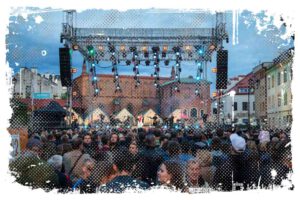Interested in the story behind the Ghetto Heroes Square in Kraków? Then, let me take you back to 1838, when this square was first marked out. At the time, it functioned as a sidekick to the main market of the city of Podgórze. People didn’t really have a name for it until the 1880s when it became known as the Small Market. Things changed in 1915, when Podgórze became part of Krakow and the square received the name of Zgoda Square, which means 'Unity Square’. Why? Well, because Krakow already had a Little Market Square.

Ghetto Heroes Square – A Look into the Square’s Past

As we journey further into history, I think it’s crucial to mention that during World War II, this square was the heart of the ghetto. The Germans set it up for the Jewish population on March 3, 1941. Now, if you’re wandering around house number 18, you should know it was once the only pharmacy in the ghetto. Tadeusz Pankiewicz, the sole Pole living there, ran it. Let me say, his courage was remarkable. He risked his life to aid his neighbors and witnessed the horrific events of the ghetto’s liquidation on March 13 and 14, 1943.
The Mysterious Iron Chairs – What is it?

As you stroll through Podgórze in Krakow and glance at the Ghetto Heroes Square, you might question the array of puzzling iron chairs scattered across the square. You may also wonder about the name, which harks back to the Krakow ghetto during World War II. What’s the story behind the intriguing art installation erected in 2005? What was Zgoda Square before the war and how has its story unfolded?
The History of Ghetto Heroes Square
Until 1915, Podgórze was an independent town boasting two markets: the Main Market Square and the Small Market. Following its integration into Greater Krakow, the city council decided to rebrand the Small Market Square as Plac Zgody. Over the years, this square functioned as a marketplace. Soon, buildings sprouted around it, hosting shops, bars, and pharmacies.
↳ Make sure to read my guide to the most amazing places to stay in Kraków:
How to Find Best Place to Stay in Krakow Old Town – Your Guide
Before the Darkness Fell
Before Podgórze’s main squares became associated with the eradication of Krakow’s Jewish residents, it evoked rather positive vibes. From 1930, for many locals, Zgoda Square was the starting point for holiday trips. It was during this time that the bus station, designed by Adolf Siódmiak, popped up on what we now know as Ghetto Heroes Square.
Suddenly, the square transformed into the Karpaty bus station. Buses managed by the Polish Tourist Association took off from Podgórze. Trams also rolled in here. Yes, it’s worth mentioning that this was once a bustling hub of the city before the events of World War II took over its narrative.
Ghetto Square during the Ghetto’s Existence
Imagine this. It’s 1941, and you’re standing in front of the former station building, which today, has been slightly rebuilt. The dates 1941 and 1943 are etched on the building, reminding everyone about the Krakow ghetto established on March 3, 1941. The station buildings have been repurposed as a guard post for the so-called 'blue police’.

The once bustling square is now encompassed by a ghastly ghetto wall, traces of which can still be seen in Podgórze. The square’s layout is a bit different from what we see today. Targowa Street used to cut right through the middle, the evidence of which can be seen in the unique arrangemen5\t of the cubes in the square.
As you wander the ghetto, it’s divided into part A and part B. Part A is filled with people capable of working, while part B is home to the sick, elderly, and children. The border between these two parts runs along Zgoda Square.

Here, you’ll also find one of the gates leading into the Krakow ghetto. The Eagle Pharmacy, managed by Tadeusz Pankiewicz, the only non-Jewish resident, sits on this square. This well-known building is a hub for the underground and the elite of the ghetto. After deportations, residents gather at the pharmacy to share updates about survivors. The pharmacy employees act as a bridge to the outside world.

The square, known as Plac Zgody (Consent Square) back then, witnessed the most horrific events during the ghetto’s liquidation. It’s here that the last residents of the ghetto were gathered before being transported by trucks to Auschwitz. Those who remained were led to the camp in Płaszów.

Ghetto Heroes Square after the War
Fast forward to July 30, 1948, when Zgoda Square became Ghetto Heroes Square. The station buildings, once used by the occupiers, welcomed passengers again. The square regained its status as a major hub in the following years.
By October 2003, plans were afoot to rejuvenate the square, with a competition for its reconstruction being announced. The selected project got underway in July 2005 and concluded by the end of the year. In December 2005, a thougth-provoking installation by Piotr Lewicki and Kazimierz Łatak materialized on the square.

There were 33 metal chairs symbolizing the possessions of the displaced ghetto residents, reminiscent of the chairs described in the book „Pharmacy in the Krakow Ghetto”. Alongside these metal chair-sculptures, wooden chairs were also installed.
As if one art installation wasn’t enough, another one sprang up after a decade or so. In April 2017, the square’s chairs were given a makeover. Artists crocheted 'clothes’ for the chairs. Not all of them have survived, but worn lace still adorns one of the chairs.

Despite the revitalization being recognized in the European Prize for Urban Public Space competition, I have to ask, is the installation clear enough for those unfamiliar with the history of Ghetto Heroes Square? Feel free to share your thoughts on Facebook!
References:
- https://pl.wikipedia.org/wiki/Plac_Bohater%C3%B3w_Getta_w_Krakowie
- https://www.krakow.pl/instcbi/11195,inst,4812,307,instcbi.html



